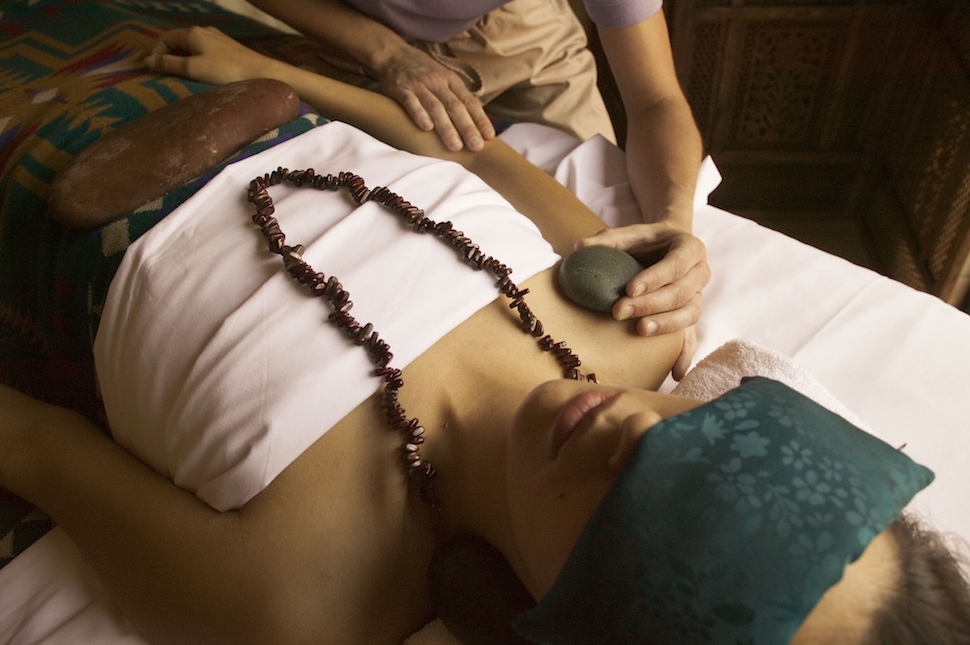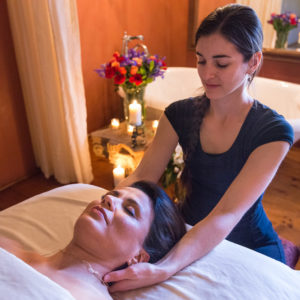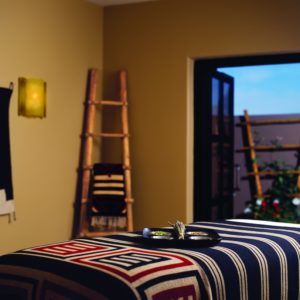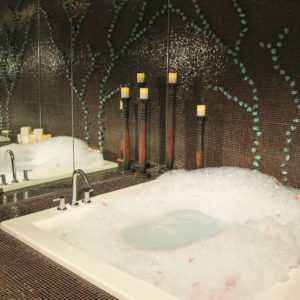
I’ve visited Santa Fe on and off for most of my life. To my child self, the orange adobe city exuded a sorcerous quality. It seemed like a surreal portal to something magical, an outpost that hovered neither here nor there—a site that might have been the sacred, amorphous, in between. When I conjure my earliest memories, they include enchanted snapshots—a curandera sweeping with a twig broom in front of an herbal medicine shop on the main square, a Native American jewelry maker explaining to me that the spiral shape in her work symbolized the soul’s journey, some husky horses galloping me home as guardians during a thunderstorm, and the legend that the miraculous, spiraling Loretto Chapel staircase, purportedly built in one day (and without nails) by a mysterious man was constructed by Jesus—or at least a corporal saint. In its modern incarnation (more developed, more focused on tourism), Santa Fe remains a bricolage of profound cultures (from Native American to old-world Spanish), set in a high-desert clime, wedged amid red sand and chunky rocks. Drawn by its light and colors, inspired by the bounty of its melded histories, artists have flooded the city throughout the decades, as have tourists, restauranteurs, businesspeople, hoteliers—and healers.
For those seeking transformation, Santa Fe uniquely stands out. When the Spanish slogged across the Southwest, conquering and exploring, they brought with them their own natural plant cures, including rituals learned from the Moors and the Romans, both of whom had occupied Spain. From the Aztecs in Mexico and indigenous people living in what became the United States, the Spanish learned about local herbs, regional curative techniques, and the benefits of healing waters. The blending of these organic medicinal techniques, combined from a variety of ancient heritages, created a wing of the healing arts all its own. Called curanderismo, this still vibrant shamanic culture has deep roots across New Mexico. There’s even a popular course taught annually in Albuquerque at University of New Mexico.
 I experience the reparative effects of some Santa Fe-gleaned curanderismo during a recent stay at the Inn & Spa at Loretto, now a member of Heritage Hotels. Restored masterfully by Zimmerman and Associates, the re-envisioned, former Catholic school stylistically celebrates the ancient Pueblo peoples of New Mexico. An elegant array of artifacts, paintings, and design elements, from frescos to talavera tiles, pay homage to Santa Fe’s prodigious history, while well-trained, five-star staff welcome guests as old friends. But, it’s in the Spa at Loretto, helmed by Suzanne Chavez, herself a gardener, apothecary expert, energy healer, and aromatherapist, where I feel the therapeutic powers of Santa Fe shift my soul on the deepest level. During my Renew OxyGeneo™ Facial with Moreen Gomez, a therapist endowed with an amazingly calming energy flow, my chakras receive that dose of centuries-old wisdom that clears the proverbial slate. While the technologically advanced, oxygenating facial (possibly the best I’ve ever had) resulted in measurable results, the glow I present afterwards has even more to do with Gomez, Chavez, and the spa’s particularly restorative, curanderismo-inspired ambiance.
I experience the reparative effects of some Santa Fe-gleaned curanderismo during a recent stay at the Inn & Spa at Loretto, now a member of Heritage Hotels. Restored masterfully by Zimmerman and Associates, the re-envisioned, former Catholic school stylistically celebrates the ancient Pueblo peoples of New Mexico. An elegant array of artifacts, paintings, and design elements, from frescos to talavera tiles, pay homage to Santa Fe’s prodigious history, while well-trained, five-star staff welcome guests as old friends. But, it’s in the Spa at Loretto, helmed by Suzanne Chavez, herself a gardener, apothecary expert, energy healer, and aromatherapist, where I feel the therapeutic powers of Santa Fe shift my soul on the deepest level. During my Renew OxyGeneo™ Facial with Moreen Gomez, a therapist endowed with an amazingly calming energy flow, my chakras receive that dose of centuries-old wisdom that clears the proverbial slate. While the technologically advanced, oxygenating facial (possibly the best I’ve ever had) resulted in measurable results, the glow I present afterwards has even more to do with Gomez, Chavez, and the spa’s particularly restorative, curanderismo-inspired ambiance.
The ode to sense of place at the Spa at Loretto is palpable upon entry. Chavez scrupulously sets the mood by honoring and channelling the ancient healing traditions of the indigenous New Mexican populations. “The use of herbs, minerals, animal totems, prayers, and blessings were the tools of the earliest healers and medicine people,” she says. She points out that ancient people knew that they were a part of the cycles of nature. “They did not consider their physical form a separate entity from nature or spirit. Being in tune with nature and using remedies provided by the earth and spirit was a fundamental practice and way of life,” she explains.
Chavez spent years searching for aromatherapy lines, scrubs, and oils to use, but had come to the conclusion that many lines did not pass muster. “I was in search of high-integrity, organic, mindfully sourced and harvested, effective, high-vibrational products. Plus—of course, they had to smell fantastic and feel right on the skin.” Informed by her background in gardening and aromatherapy, Chavez commenced developing her own products. “I began to source organic essential oils, herbs, and flowers, and my office became my apothecary workshop.” In the last few years, Chavez has introduced a plethora of effective aroma blends into her treatment menu, including a popular High Altitude Relief Oil, a godsend at 7,000-feet. The spa-made scrubs featuring sage and lavender harvested from Chavez’s home garden are best-sellers in the shop.
An urban retreat, the Inn & Spa at Loretto relays the spirit of Santa Fe, old and new, throughout. Don’t miss its pool, cannily anchoring the courtyard and its ambient restaurant. In the spa, modern bodywork and carefully curated traditional remedies ensure guests experience both the sacred and the authentic.
Three More New Mexican Havens in the Curative Spirit
 The Hyatt Tamaya, Albuquerque
The Hyatt Tamaya, Albuquerque
On the verges of Albuquerque, among a forest of cottonwood trees, with views of the Sandia Mountains, this family friendly resort sprawls across 550 acres amid the Santa Ana Pueblo. As a celebration of the Tamayame people, it reflects the region via its architecture, cuisine, activities, and in its Tamaya Mist Spa. After a horseback ride or hike through the forest, indulge in the Ancient Drumming Treatment. You’ll be coated with a layer of Jemez mud and chile peppers, then rhythmically thumped with soothing, herb-filled muslim pouches. A pinon and salt body scrubs makes for an exhilarating grand finale. Ask for Kim, whose healing energy is paramount to a recharge of the mind, body and spirit.
Ojo Caliente Mineral Springs Resort & Spa, Ojo Caliente
Humans and animals have been taking the curative waters of Ojo Caliente, a high-desert retreat hemmed in by rocky cliffs, for more than three thousand years. The various springs pump out 100,000 gallons of salubrious geothermal waters daily, warm H20 fortified with lithia, iron, arsenic, sulphur, and more. In 1968, Ojo Caliente Mineral Springs Resort & Spa began receiving customers, making it one of the oldest known health retreats in the United States. Today, it remains an earthy, low-key place, chill enough to feel accessible to anyone, though costly and chic enough to lure weary urbanites like a deserved indulgence. Most unusual, it offers myriad pools, each potently infused with a majority mineral, each labeled to explain what ailments it might ameliorate. Soakers tend to wander from pool to pool, slathering themselves in the mud area, then moving on to the feel-good effects of the lithium tubs. Located between Taos and Santa Fe in an area that seems deliciously remote, the resort has pueblo-style bungalows and rooms spread across 70 acres. Consider the vintage trailers for a throwback stay.
El Monte Sagrado, Taos
 The ancient landscape around Taos in northern New Mexico is one of the only places on earth that yields fairy crosses—also known as staurolite. Taking the shape of a cross, the highly prized crystals have long been carried to ward off illness, calm the spirit, or heal the wounded. Even Teddy Roosevelt carried one for good luck. When I was a child, I was told that putting one in my pocket would help me communicate with animals. Ingeniously, The Living Spa at El Monte Sagrado hotel in Taos offers a truly grounding signature treatment, The Sacred Staurolite. Expect to be lined from throat to sacrum with fairy crosses, wrapped in turquoise, dry brushed, and massaged across the scalp. A splendid haven of a hotel that embodies the unique artsy-meets-Western, mountain-meets-pueblo vibe of the region with just the right hint of luxury, El Monte Sagrado is ideal for family or romance travelers.
The ancient landscape around Taos in northern New Mexico is one of the only places on earth that yields fairy crosses—also known as staurolite. Taking the shape of a cross, the highly prized crystals have long been carried to ward off illness, calm the spirit, or heal the wounded. Even Teddy Roosevelt carried one for good luck. When I was a child, I was told that putting one in my pocket would help me communicate with animals. Ingeniously, The Living Spa at El Monte Sagrado hotel in Taos offers a truly grounding signature treatment, The Sacred Staurolite. Expect to be lined from throat to sacrum with fairy crosses, wrapped in turquoise, dry brushed, and massaged across the scalp. A splendid haven of a hotel that embodies the unique artsy-meets-Western, mountain-meets-pueblo vibe of the region with just the right hint of luxury, El Monte Sagrado is ideal for family or romance travelers.
Becca Hensley
Becca Hensley is Editor at Large for Insider's Guide to Spas. Based in Austin, she writes regularly about travel and spas. She believes a good story draws you in like laughter in a crowded room, and challenges you to do it justice. Her work appears regularly in Austin Monthly, Travel Channel, Toronto Star and National Geographic Traveler.